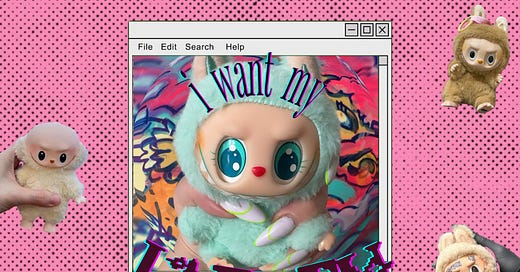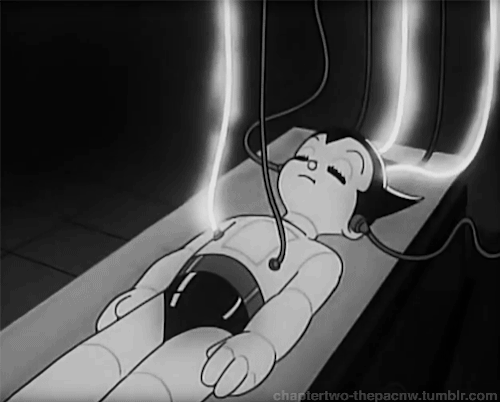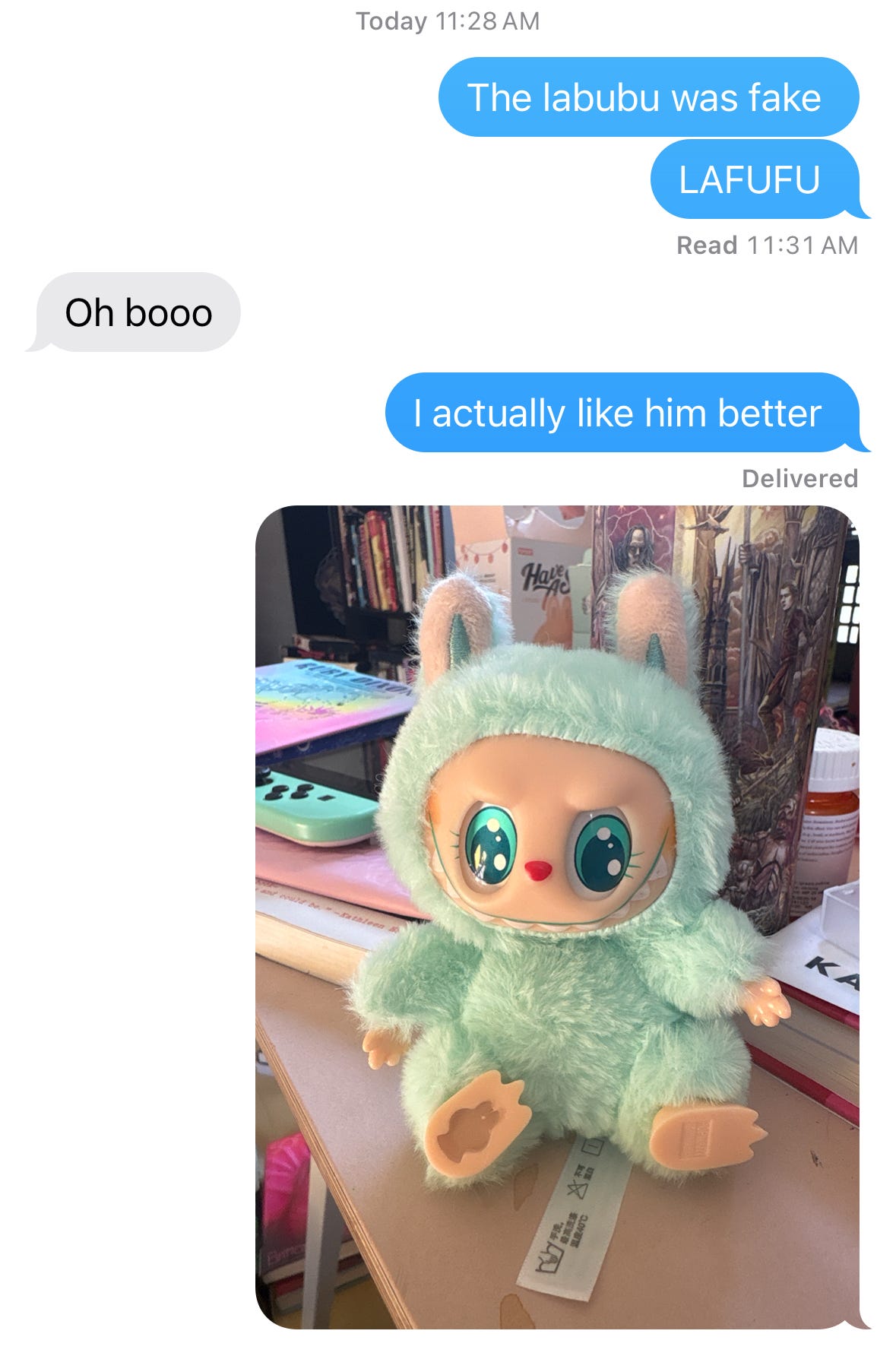I Want My Lafufu
what accidentally buying a fake labubu taught me about generative AI and reality at the end of capitalism
Even though I live in the middle of nowhere, I believed that the kiosk at the nearby mall was selling Labubus.
I should have known something was up when the two lanky men stationed behind the shelves overflowing with Sonny Angel blind boxes and slippers fashioned to look like Jordans, perked up, stopping their scrolling to flank me as I examined the boxes with the little monsters grinning out at me.
I was a mark.
I shook a box. It felt real enough, like any other blind box.
“That one’s $30,” one of the guys told me over my shoulder. “But you can have two for $50.”
“I just want the one,” I said, tapping my phone to bring up my card.
I am spending an increasing amount of my time trying to figure out if what I’m seeing is fake or real.
I find myself studying videos, waiting for the person I’m watching to blink, or reading a line of text over and over again, testing out its cadence to see if it’s familiar, if my chatbot has ever spoken to me in the same way. I tell myself that taking the time to do this is important, that learning to tell the fake from the real will be a necessary skill in a few months, a few years, a few weeks.
And then I find myself thinking about how woefully unprepared I am for the world I now share with artificial intelligence, despite spending countless hours reading books and watching movies about robots. None of those stories, it seems, prepared me for the ways that reality would warp under AI, or how subtle those shifts would be. I thought I would be in a theme park, indulging a fantasy, having a robot do my laundry or else being gunned down by one. No one told me about the moment in between, the brief flash before the apocalypse, when the changes are just the wind shifting course.
I should, by now, be able to tell if something I’m experiencing is real or not. I was 11 when the dial slide to a very real set of planes flying into a very real set of buildings live, and I knew the difference between that real and the real I liked to indulge when my parents were at work and I could binge The Hills or The Simple Life or any number of reality TV series on Bravo or E! that never took off. Those were my favorite, the scripted nature of reality TV going wildly off the rails when you put people in front of the camera who would do anything to stay there.
Consuming all of this not-quite-real, not-quite-fake content from an upside down world were heiresses to multi-million dollar fortunes shoveled manure and single mothers on the outskirts of Hollywood homeschooled their daughters in the law of attraction taught me a very important lesson. Girls in America seem to learn one way or another that the faker you are, the more real you start to feel.
AI is not so sophisticated yet that it can create visual language that is convincing. When Google dropped its upgrade to its AI video-making services, VEO 3, a few weeks ago, my timeline was flooded with talking heads declaring the end of the Internet and girls in spiritual psychosis, wondering if it was all a simulation. But if you sit and watch VEO 3 videos, it doesn’t take long to notice the tells. The way the girl in the video blinks or breathes in perfect time, or laughs with her eyes a little too wide, no light behind them.
AI can’t yet fake it like I can.
There is a game girls are playing online, the scope of which is growing narrower and narrower as the trend cycle shrinks. The game is called: does she like what she likes because she likes it, or because the algorithm told her to?
At the beginning of the year, there were a rash of videos addressing the alleged death of personal style at the hands of the algorithmic microtrend cycle. As
points out in her video on the topic, looking back at the 2023-24 kaleidoscope of cores (cottagecore, barbiecore, coastal grandma core): “There’s no through line between any of these aesthetics beyond TikTok virality.” Whereas before, fashion trends were started and sustained by affinity — which ingrained our objects of adornment with a deep sense of identification, belonging, and personal storytelling — now, we like what we like because we were told to like it.Our choices are no longer all that human.
Into this space of hyperconsumption driven by the algorithm, fake Labubus — Lafufus — enter as a strange talisman. The Lafufu is an aberration, a glitch that reveals a level of desperation, of wanting something so badly that you ignore the empty promise of what’s really in front of you: the bag charm that is clearly fake, with its head twisting around and eyes bulging and fur sticking out at odd angles.
I began to suspect my Labubu was fake when I returned to the mall to purchase a second blind box and saw that that day’s set of boxes bore no title. But in the moment, I had been willing to look past the scam because I wanted a Labubu and I couldn’t believe my luck having found one at the mall.
Later that day, the same day I unboxed my Lafufu, I was having ChatGPT scour the Internet for essays I could read about bedrotting.
Writing this sentence, I feel like I need to pause the story because you have now grown somewhat suspicious of me. I imagine you, your fingers poised over the image of a keyboard on your phone, ready to pluck my sentence from my essay and feed it back through the machine, show people, show another AI and ask it, “Is this AI?” I imagine that you no longer trust me because I have admitted to doing this thing that all of us do but most of us do not talk about: using generative AI.
I feel the pressure to explain to you that I do not prompt AI to write things for me, which is to say I do not ask it to think for me. I feel suddenly defensive, eager to let you know that my writing is real and it is my own. But knowing that I touched the machine is enough to be suspicious of me. I understand.
ChatGPT returned a list of essays about bedrotting, none of which are real.
They sounded real enough, their titles believable, their publications appropriate. I maybe wanted them to be real because that would make building my argument easier. I could bypass the whole part where I go, this thing is relevant and important because it says X about Y. Instead, I could outsource that labor to another writer who has already done that work, an older practice we call citation.
But in the end, they weren’t real articles. They were what the Internet calls hallucinations: what happens when artificial intelligence begins to dream.
These hallucinations AI has are convincing for a moment, but it only takes a few clicks to discover that they aren’t real, just fake ideas my chatbot thought would satisfy me. We want our questions to have answers, and AI often appears to us now as a golden calf, the sparkling idol we constructed in a desert when we were afraid.
I suspect that the rate at which we are consuming AI generated content is far greater than we realize. Because AI is in the ideas, the way we repeat and share information across social platforms, the content and the way content is able to replicate itself endlessly. We aren’t in an echo chamber or a vacuum anymore. We’re in a place where the fake ideas, the hallucinations of our machines are the spores that we are breathing in, always around us and everywhere.
One of my favorite subgenera of videos as the frenzy to obtain a Labubu has reached a fever pitch online are the videos of the girls unboxing Lafufus. In some of these videos, the Lafufu is hilariously bad: poorly made, forehead too big, falling apart at the seams. The girls unboxing the Lafufus often collapse into a fit of giggles, inviting viewers to join in on the fun and enjoy their folly in falling for a scam.
In other videos, however, the creator seems blissfully unaware that their Labubu is not real. And these videos are uniquely interesting to me because if the emotions invoked by unboxing a Lafufu are the same as if the girl was opening a Labubu, who are we to say that her experience, her joy, is not real?
 Tiktok failed to load.
Tiktok failed to load.Enable 3rd party cookies or use another browser
There is one Lafufu unboxing video that I can’t stop thinking about, but not because the Lafufu the girl received was hilariously bad or because her reaction was all that interesting. I can’t stop thinking about what didn’t happen.
 Tiktok failed to load.
Tiktok failed to load.Enable 3rd party cookies or use another browser
It starts benignly enough: a girl setting her phone on the counter to film herself unboxing a Labubu that she’s miraculously found in a souvenir shop in New York.
“Sir, are these real Labubus?” she says, giggling as she interrogates the man behind the counter, who assures her that they are, in fact, real.
But then something strange happens. As she rips open the box with a huge grin on her face, voices off camera begin to shout at her to pay first before opening. Her hands fly into the air and the scene teeters on the edge of becoming something very different for a split second — “Wait, guys, I’m not going to rob you of your Labubus” — before she rips open the bag and screams.
“I GOT THE PINK ONE!”
In 2012, I was working at another mall in a less middle-of-nowhere part of Ohio. I had just graduated with honors from a university that routinely ranks in the top five of the country, where my classmates sold t shirts in the student union that read, “If I had wanted an A, I would have gone to Harvard.”
But instead of joining my peers at prestigious internships or the kinds of post-grad summer jobs that only go to nepo babies, I returned to Ohio, got a job at a store in the mall known for selling blazers and statement necklaces, and enrolled in a real estate program at Hondros College, a for-profit institution run by a local real estate brokerage that, at the time I was enrolled, had no accreditation. I was there because a man who had grifted his way into my parents’ lives as a spiritual leader sometime in the early 1990s was now routinely trying to get them to disown me and I needed to stay close to home.
But I’m here to tell you about working at the mall.
The very first thing you learn when you work at a store like the one I was at, which caters mostly to upper middle class white people, is that these types of stores do not care about shoplifters. In fact, stolen merchandise is accounted for in their budget, a line item they can write off at the end of the tax season.
In one of my very first training sessions, I was told that if I saw a customer stealing things, I had two options: ignore them or approach them and tell them about any sales we were having. I was never to accuse a customer of stealing or call mall security on them because the type of customer who shopped at our store did not steal.
And so, I saw a lot of people steal a lot of things from the store and I never said anything about it. I let them walk out the doors, setting off the security monitors that flanked the exit, and go on their way. I only ran into trouble when a customer wanted to get caught, which happened to me one weeknight night a few minutes before closing when a tall, lanky white woman whose arms were bedecked in plastic bangles cornered me in the fitting room.
She was running a scam I had seen before: the one where a customer keeps asking for different sizes and, between running back and forth from the backroom to retrieve merchandise for them, I forget that they had five pairs of stiff, dark wash denim and not three, the remaining two already stuffed deep in their designer purse.
But something about this customer was different. She had a wild, hungry look to her when she opened the door to the fitting room to receive the extra pairs of jeans I had brought for her.
“Can you stay?” she asked, her bony fingers wrapping around my wrist. “I want your opinion on how these look.”
I didn’t want to, but I nodded and she pulled me into the fitting room, her breath sticky. As she wrenched the jeans over her frame, she began rambling about her sciatica, how much pain it caused her. And then she started asking questions about our return policy, where we sourced our denim, things I can’t even remember now because in the moment, I was backed into a corner by a woman whose hair was frazzled and whose blue eyes were red in the wrong places.
This was part of the show, an extra layer of performance that she needed because just stealing the clothes was not enough, that was too boring, too safe. She had seen all the way to the bottom of the grift and found it empty, lonely.
And so we stood there, locked in this silent agreement that she could take the merchandise and I would do nothing about it. It became clear to me that she no longer wanted to be a part of this agreement. She wanted something real: for me to tell her she couldn’t steal, that security was on their way to collect her.
I didn't. I let her walk out of the store with several pairs of jeans at a necklace at the bottom of her bag and cleaned up the fitting room she had trashed.
A few weeks later, there was a commotion at the front of the store. It was a busy Saturday afternoon but everyone still rushed to the great big glass windows at the front to see what was going on. Mall security had run down a man and four officers were currently hog tying him in front of our shop.
Was this what my customer had been hoping for when she cornered me in the fitting room? Had she grown tired so tired of her freedom, her privilege, that it had become a cage she needed to escape? How to tell her that, even if she were to switch places with the man in front of me, she still wouldn’t touch what’s real in this country?
As mall security dragged the man away, my manger, Coby, clicked his tongue. “Must’ve been at the GAP,” he said, turning on his heel and heading back towards the cash wrap.
I entered a grad program the next year, but my year at the mall stayed with me. I had tried things the honest way: getting a spot at an elite university where I worked my ass off getting the grades I did, winning awards and fellowships for my writing, and holding down three different jobs.
But now I understood the value of the grift, the scam, the other side where you dressed up what you really wanted in velvety lavender bleach that turned your hair platinum blonde and fake leather pants that hugged your hungry body just right.
I didn’t want to be real anymore. I wanted to be underestimated, to block out all the darkness in my life by giving people a show that was as enthralling as it was empty. I had ancestors who knew this path before me, who embraced the ultra-fake as a way to survive: Vaginal Creme Davis and Candy Darling and Britney Spears.
I tried to tell a boyfriend as much as we peeled into the parking lot of an apartment complex I would soon be evicted from late one night after his shift at an upscale cocktail bar.
“You don’t have to do your hair like you do, Rachel. You’re getting your fucking doctorate and all they’re seeing is big boobs and blonde.”
“I know,” I told him. “But I like it that way.”
In professional wrestling, there is an acknowledgement that what you are seeing isn’t really real. Yes, these men are hitting each other, beating one another into the ground, making each other bleed. But the sport is performance, a hand shake before the match. There is consent: you will make me bleed and I will like it. This agreement exists, too, between the viewer and the performers. They even have a term for it: kayfabe, the invitation for you to suspend reality and just enjoy the show.
I’m going back for more Lafufus. I don’t want to dress them up or resell them or unbox them on the Internet or pass them off as real.
The fake that I can tell is fake is so valuable to me now. I want to surround myself with it, create shrines to it, sear it into my memory so I always know it. Because someday, I won’t be able to tell anymore. There will be no more contract, no more consent, no more kayfabe. The differences between what’s fake and what’s real will cease to exist, and we’ll be left, babbling in the dark.
WOW this essay GOT PERSONAL (personal for me is talking about the time I worked at the mall lol). In any case, if you made it this far thank you SO SO much for reading!!! This essay really came out of nowhere for me but felt really good to write.
As always, if you like my writing and want to support it, you can upgrade to a paid subscription right here. Paid readers get access to my digital zine of monthly faves too, plus you’ll be helping me have the space and time to write these longer essays!!!
A couple of other things: first, my essay collection is still on sale for just $10. I have 40 copies left and once they’re sold out, they’re gone for good. So grab your copy here while you still can! If you are international and want a copy, just DM me or hit me up over on instagram girlgutters and we’ll get you sorted.
If you missed last month’s zine, you can go check that out right now:
And I started Internet Bedroom TV over on YouTube, where I’m posting behind the scenes writing stuff, video essays, and also teaching a lil about my approach to writing and being a writer online. I’m actually really proud of the videos I’ve put out over there because I’m very much camera shy and getting comfortable on camera has just opened up a lot for me personally and professionally! Maybe another essay in the making — “against content part 2.”
Speaking of the real fakes, have you guys listened to the new Addison Rae album?? Thoughts??? Let me know below. As always, thank you for being here <3 <3 <3













I found you on Youtube first and watched one of your Substack videos.. I LOVE your writing! Happy to follow along on Substack :)
This was absolutely fabulous and so engaging … with so many twists and turns! 👌🤭